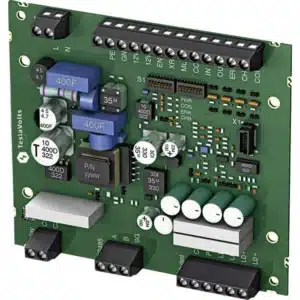As electric vehicles (EVs) gain momentum, optimizing charging infrastructure becomes paramount. Teslavolts, an industry pioneer, has integrated cutting-edge AI logics into its Intelligent Charge Controller (IC3) to enhance EV charging efficiency, minimize battery degradation, and maximize battery lifespan. This blog explores how Teslavolts is setting new standards in the EV charging industry, delivering high-speed, optimized charging for two-wheelers, four-wheelers, and trucks.

Optimizing Battery Degradation and Fast Charging
One of the major challenges in the EV sector is managing battery health while providing fast charging. Teslavolts addresses this by integrating AI-driven algorithms into its IC3, optimizing the charging process to reduce battery stress. Here’s how it works:
Ai Optimized Charging Profiles: AI algorithms dynamically adjust charging profiles based on real-time data, ensuring that each charging session is tailored to the battery’s current state. This minimizes heat generation and chemical wear, leading to reduced degradation and extended battery life.
Predictive Maintenance: By continuously monitoring battery performance, AI can predict potential issues before they become critical. This proactive approach ensures timely maintenance, preventing unexpected failures and prolonging battery life.
Load Management: AI logics distribute the electrical load intelligently across multiple charging stations, balancing the grid demand and avoiding peak load times. This not only ensures efficient energy use but also supports the overall stability of the power grid.
Enhancing EV Range and Lifespan
Fast charging often comes with the trade-off of increased battery wear. Teslavolts’ AI integration addresses this by:
Adaptive Charging Speeds: Depending on the battery’s condition and charge level, the system can modulate the charging speed. For instance, it may slow down the charging rate as the battery nears full capacity to avoid overcharging and reduce wear.
Optimized Charging Cycles: AI optimizes the charging cycles to ensure that batteries are charged in a way that maximizes their usable life. By avoiding deep discharges and excessive charging, the AI ensures that each charge delivers the best possible range.

Industry-First EV Charging OS
Teslavolts introduces the first EV Charging Operating System (EV Charging OS), an innovative platform that enables seamless integration and scalability:
Modular Architecture: The EV Charging OS allows for modular upgrades, meaning that new technologies and enhancements can be incorporated without overhauling the existing infrastructure. This future-proofs the charging stations and significantly reduces upgrade costs.
Scalability: With this modular and scalable architecture, manufacturers, infrastructure developers, and Charge Point Operators (CPOs) can expand their networks effortlessly. New charging stations can be added, and existing ones can be upgraded with minimal disruption and cost.
Cost Efficiency: The integrated AI and modular design lower the overall cost of development, deployment, and management. This makes it more affordable for stakeholders to invest in and expand their EV charging networks.
The Future of EV Charging
Teslavolts is not just keeping up with the evolving demands of the EV market; it is driving the change. By integrating AI logics to optimize battery performance and introducing a scalable EV Charging OS, Teslavolts is setting new benchmarks in the industry.
For Manufacturers: They can now offer more reliable and longer-lasting EVs, boosting consumer confidence and adoption.
For Infrastructure Developers: The modular architecture means lower upfront and ongoing costs, making it easier to build and expand charging networks.
For CPOs: Efficient load management and predictive maintenance reduce operational costs and improve service reliability.
Teslavolts innovative approach is paving the way for a more sustainable and efficient EV ecosystem. By leveraging AI and a first-of-its-kind EV Charging OS, Teslavolts ensures that EV charging is not only faster and more efficient but also smarter and more future-proof. This integration marks a significant leap forward in the journey towards widespread EV adoption and a greener future.




